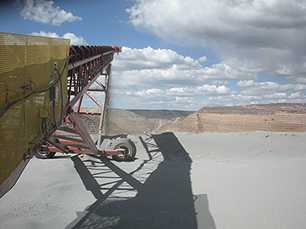Mining Project: Monitoring and Control of Airborne Toxic Substances in Mining
| Principal Investigator |
|
|---|---|
| Start Date | 10/1/2013 |
| Objective | The objectives of this project are (1) to advance the assessment and monitoring of exposure to respirable aerosols in mining, namely crystalline silica, coal dust, and DPM, through the development of timely, accurate, and site-specific monitoring technologies and strategies, and (2) to evaluate and implement advanced and emerging diesel emissions control technologies. |
| Topic Areas | |
Research Summary

NIOSH visited a metal mine operation in March 2016.
Workers in the mine environment can be exposed to high levels of toxic aerosols, including crystalline silica and diesel particulate matter. Inhalation of respirable crystalline silica can cause silicosis, an incurable and potentially fatal lung fibrosis. One of the most significant hurdles in controlling exposure to crystalline silica is the inability to rapidly monitor the exposure. To address this problem, one focus of this project will be to develop field-based silica exposure monitoring solutions. These solutions, namely end-of-shift (EoS) or in-shift, will empower mine operators to avoid or mitigate high crystalline silica levels in the mine environment.

NIOSH dust chamber ready to test dust from an iron mine (April 2016).
In 2012, the International Agency for Research on Cancer (IARC) labeled diesel exhaust as a human carcinogen, and a recently published NIOSH study reported that heavy exposure of miners to diesel exhaust increases the risk of death from lung cancer. Therefore, another focus of this project will be to evaluate complex diesel engine exhaust after-treatment systems designed for simultaneous control of both nitrogen oxides (NOX)—a component of diesel exhaust—and diesel particulate matter (DPM) emissions for application in mine environments. These Environmental Protection Agency Tier 4 technologies are rapidly evolving but are not optimized for underground mining. To protect worker health, research is needed before widespread implementation of these engines in the mining environment.
.jpg)
The Tier 4 diesel engine that will soon be tested in the OMSHR Diesel Laboratory.
This work will be carried out by way of three research aims:
- Assess the performance and implementation of end-of-shift or in-shift solutions for monitoring crystalline silica in mining.
The goal is to recommend the implementation of promising solutions to the mining industry. The team will consider both commercially available technologies and strategies and the design of innovative techniques. The commercially available candidates will be optimized and revised for the targeted need of specific mining environments. When possible, researchers will pursue the integration of the identified solutions with monitoring devices and technologies currently used in mining. - Evaluate the suitability of advanced and emerging medium- and heavy-duty diesel engine emissions control technologies for mining applications.
Two Tier 4 engines similar to the ones that will be used to power underground mining heavy-duty applications will be tested for the laboratory part of the study. One of the selected engines should be representative of those tuned for low engine-out DPM emissions and equipped with a selective catalyst reduction (SCR) system. The second engine should be representative of those engines tuned for relatively low engine-out NOX emissions and equipped with a diesel particulate filter (DPF). - Assess the performance of the DPM sampler currently used in M/NM mines.
The goal is to improve the DPM sampler by testing it in the presence of different levels of mine dust aerosol and evaluating potential sampling alternatives.
In addition, NIOSH’s statutory obligation to approve new and modified coal mine dust sampling devices under 30 CFR 74 will be fulfilled in the frame of this project.
Project Team
William Archer - Electronics Technician
Teresa Barone - Associate Service Fellow
Aleksandar Bugarski - Mechanical Engineer
Emanuele Cauda - Senior Service Fellow
Lauren Chubb - Physical Scientist
Jon Hummer - Engineering Technician
Jason Pampena - Associate Fellow
Donald Tuchman - Industrial Hygienist
Shawn Vanderslice - Engineering Technician
New YouTube video - Faces of NIOSH - on the new field-based approach to silica monitoring for mines
See Also
- A CART Technique to Adjust Production from Longwall Coal Operations under Ventilation Constraints
- Diesel Exhaust Aerosol, Review of Measurement Technology
- Evaluation of Sequential Extraction Procedures for Soluble and Insoluble Hexavalent Chromium Compounds in Workplace Air Samples
- An In-Situ Diffusion Parameter for the Pittsburgh and Pocahontas No. 3 Coalbeds
- Instrumentation for Diesel Particulate Matter Emissions Research
- Morphological and Elemental Classification of Freshly Emitted Soot Particles and Atmospheric Ultrafine Particles using the TEM/EDS
- Real-time Neural Network Application to Mine Fire - Nuisance Emissions Discrimination
- Ringelmann Smoke Chart
- Sonic Anemometer Airflow Monitoring Technique for Use in Underground Mines
- Use of Vacutainers for Collection of Mine Atmosphere Samples
- Page last reviewed: 10/22/2016
- Page last updated: 10/22/2016
- Content source: National Institute for Occupational Safety and Health, Mining Program


 ShareCompartir
ShareCompartir